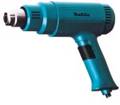
 TM
TM

A primer for heatgun/dogbowl coffee roasting
by Michael Lloyd All rights reserved. No portion of this page may be reproduced without consent of the author.
The earliest mentions of using a heatgun and a roasting
vessel to roast coffee go back to the early 1990’s on the Net and in the
alt.coffee Usenet newsgroup. Attaching
a roasting chamber filled with coffee beans to a heatgun muzzle goes back even
further. This technique, developed
by Michael Sivetz to roast coffee samples, uses the Wagner HT 775/Milwaukee 750
heatgun still available today.
Since the last quarter of 2003, this older method has become more popular. Why the sudden upsurge in interest over the heatgun? Theories abound, but one possible reason is a backlash against expensive and unreliable roasting appliances that often do not work well out of the box and can require juryrigging or additional equipment to obtain good results. By contrast, the heatgun method has low entry costs and the equipment is simple and robust, producing a significant throughput of a quality roast. It combines elements of both an air fluid-bed and conduction roast. Roast times can be controlled to produce a quicker, brighter roast or a slower, fuller roast. Thus one simple and inexpensive equipment setup can replicate either an air roast or drum roast. This method is probably the cheapest means of producing significant batch sizes at nominal costs. The closest competitors are the HotTop at $ 600 and roasting nine ounces, the AlpenRost at $ 280 and roasting eight ounces and BBQ grill roasting drums at $ 125-210 and capable of roasting up to four pounds on your existing gas BBQ grill.
Through the efforts of an intrepid group of experimenters at Coffeegeek.com, to include Martin Lipton, Jim Liedeka and Michael Lloyd as the early adopters, the heatgun method has recently undergone a great deal of refinement and some recommendations are presented here on equipment and technique. Michael Lloyd is the originator and author of this primer and any mistakes are entirely his. The intent of this primer is to allow someone with basic roasting experience to use the equipment and techniques described here to get a good roast from the very first.
As with all methods of coffee roasting, the heatgun method involves high temperatures and care should be taken to avoid personal injury and property damage.
Here
are some pros, cons and basic equipment of heatgun/dogbowl roasting to think about:
Basic equipment needed:
Heatgun
Roasting vessel
Stirring utensil
Metal colander or other cooling method
Pros:
Entry
costs are low
Excellent control over roast
Capable of large batch sizes (5 to 16 oz.)
Necessary equipment is simple and robust
Easy to monitor the roast
Able to immediately halt roast at any point
Can roast 2-3 lbs. per hour
Even roasting
Quality of results dependent on operator technique
Rapid learning curve
Allows user to determine a range of fluid bed to drum roasting conditions and results by varying airflow and length of roast
Easy
to roast small amounts for blending
Cons:
Must
be done outside due to smoke and chaff
Not a ‘set and forget’ method
More difficult to precisely reproduce results at every
roast
Requires separate cooling method
Difficult to monitor roast temperature
Requires holding the heatgun and stirring for 10-15
minutes
Quality of results dependent on operator technique
The equipment essentials
The most important piece of equipment for this method is
the heatgun. For those unsure of
what a heatgun is, think of a handheld hair dryer capable of reaching
temperatures of 250-1100 degrees and powered by electricity.
Heatguns are commonly used for stripping paint, bending plastic,
plumbing, electronics assembly, arts and crafts and can be found in the paint
department of most hardware stores. Heatgun
prices typically range from $ 25 for light-duty home use models to $ 175 for
industrial models.
Work is still ongoing to find which models of heatgun are
suitable for coffee roasting. Makita,
Wagner and Milwaukee models have been popular choices to date. Preliminary
data from user reports indicates that the heatgun should be capable of at least
500 degrees Fahrenheit and have an air velocity of at least 14 cubic feet per
minute (CFM) in order to achieve sufficient heat transfer to reach roasting
temperatures. The higher the wattage
of the heatgun, the more efficient it is for roasting.
Some users report that an adjustable temperature allows them to better
ramp the roasts. A cool
setting may be useful to both cool the beans and prolong the life of the heating
element.
At this time, the following models have been used with
success:

Makita 1100
250-1100 degrees
8-14 CFM
1500 watts
$ 75
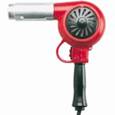
Wagner HT 775\Milwaukee 750
500-750 degrees
19-23 CFM
1680 watts
$ 60
Wagner HT 1000
750-1000 degrees
CFM unknown
1200 watts
$ 30
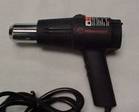
Milwaukee 1220HS
750-1200 degrees
CFM unknown
1200 watts
$ 25
Miscellaneous
issues on heatguns
One user felt that the Porter-Cable heavy duty heatgun had
too high an air velocity (27 CFM) and blew too many beans out of the roasting
vessel.
The
roasting vessel
The most commonly-used type of dogbowl (the classic) looks
like this in cross-section: \_____/.
Here are some pictures of classic dogbowls:
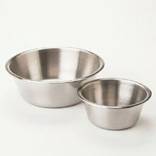
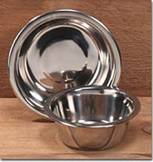
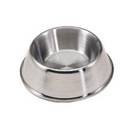
A key element of success in this roasting method is to
match the size of the vessel with the batch size.
If the vessel is too small, the depth of the bean mass will be too great,
and an uneven roast and spillage will occur.
If the vessel is too large, the depth of the bean mass will be too
shallow, and the surface area of the bean mass too large, leading to difficulty
in reaching roasting temperatures, overly-long roasts and uneven roasts.
There is a ‘sweet spot’ of bean mass surface area and depth that will
retain heat to sustain an endothermic reaction and reach first and second crack
in an appropriate amount of time. No
matter what diameter is the roasting vessel, it should be at least 2.5-3.0
inches deep to avoid blowing the beans out of the vessel.
The recommended shape is round, so that beans do not get trapped into
corners and roast unevenly.
Recommended sizes depend upon the batch size and the
diameter and depth of the roasting vessel. A
good rule of thumb would be to use a vessel with a capacity at least four times
the volume of green beans used. Using
a classic dogbowl as a typical example, a 32 oz. bowl accommodates one cup of
beans by volume; a 64 oz. bowl accommodates two cups; and a 96 oz. bowl
accommodates three cups. Although
weight per cup is only approximate and depends upon the specific bean type, a
good approximation is one level cup by volume weighs on average 5-5.3 oz., two
cups by volume weighs on average 10-11 oz., and three cups by volume weighs on
average 15-16 oz.
The material of the vessel is important too.
It has to be heat-resistant, have a smooth interior surface, easy to
clean and not subtract too much thermal energy from the bean mass.
Using cast-iron, heavy-gauge metal cookware or cookware with a clad or
sandwich metal-core bottom can create hot and cold spots.
The mass of the metal acts as a heat sink to absorb heat unevenly
resulting in prolonged and uneven roasts.
It is not known at this time if a glass, Pyrex or ceramic vessel would
give satisfactory results or be safe to use.
Stainless or carbon steel or aluminum would be good materials for a
roasting vessel. If you are using a
saucepan or cake pan, make sure the pan is uncoated, since some non-stick
materials will not tolerate the high heat of a heatgun and may release toxic
fumes.
For all of these reasons, and cost, a stainless steel
dogbowl, mixing bowl, cake pan or saucepan is recommended.
These items may already be in your home or can be purchased very cheaply
at thrift, discount, pet or department stores.
As an example, at a national chain of pet stores, a 32 oz. dogbowl sold
for $ 5.49, a 64 oz. dogbowl sold for $ 6.99 and a 96 oz. dogbowl sold for $
8.99.
Stirring utensil
A heatproof stirring utensil can be used to stir the bean
mass throughout the roast. A long
wooden or metal spoon or length of doweling works well.
A sample roast is presented here using a Wagner HT 775
heatgun and a 64 oz. classic dogbowl. Of
course, other types of heatguns and roasting vessels can work equally well.
This description presumes you have some experience with roasting.
Begin by assembling all the equipment and pour two cups
(by volume, approximately 10-11 oz. by weight) green coffee beans into the bowl.
Outside the house or in a covered and very well-ventilated
area (this method does produce copious amounts of chaff and roasting smoke), put
the dogbowl on a heatproof surface, start up the heatgun on the low setting
(side louvers open at 500 degrees), and holding the muzzle of the gun
approximately 1.0 -1.5 inches from the surface of the beans, begin playing the
heated air evenly over the surface of the beans.
If the airflow of the heatgun is not sufficient to stir
the beans, then periodically stir the beans with a heatproof utensil while
continuing to play the heatgun over the surface of the beans. After
approximately four to six minutes, the beans will begin to smell grassy and turn
a light tan in color.
Close the side louvers of the heatgun (changing the temperature to 750 degrees)
and move the heatgun muzzle to within approximately 0.5 to 1.0 inches from the
surface of the beans and continue playing the heated air over the surface of the
bean mass. As the roast progresses and the beans become lighter, you will
often be able to stir the beans solely by the airflow of the heatgun. Be
sure to stir the beans throughout the roast. Do not be alarmed if chaff
blows off the surface of the beans and catches fire. It will quickly
self-extinguish. Move the muzzle closer or further from the surface of the
bean mass as dictated by how fast the roast is progressing.
At approximately 8 minutes or so, you should reach first
crack, and second crack at about 9 minutes. When the roast is
complete to your liking, quickly dump the beans into a metal colander or cool
the beans in the usual fashion. This technique should give you
approximately three cups by volume of roasted beans. If the heatgun has a
'cool' setting, turn the heatgun to cool and let it run for a few minutes until
it is cool to the touch. This will extend the life of the heating element
in the heatgun.
The time to complete a roast also varies by volume; a one
cup roast typically takes about seven minutes, a two cup roast typically takes
about ten minutes and a three cup roast typically takes about 13-15 minutes
(these times do not include cooling). These times are also a function of
this author’s roasting experience and preference: I like a slower and ramped
roast to replicate a drum roast profile. Other people who prefer a
brighter roast, like those produced by poppers or the FreshRoast, may like to do
a two cup roast in five or six minutes. Decaf coffees will generally roast
in less time for the same volume of coffee.
The total time is very dependent on volume, heatgun used,
the roasting vessel used, ambient temperature and operator technique. If
you are roasting in very cold temperatures, the roast time may be prolonged or
you may want to put the roasting vessel into a heatproof box, tall stockpot or other container
to help retain the heat. The best
guide to the roasting process will be your eyes and ears as you monitor the
roast.
Another technique adopted by some users is to use a
gas-fueled BBQ grill to serve as another source of heat during the roast.
A non-skid/non-tip dogbowl is commonly used since the skirt acts to
retain heat under the bowl surface. The
BBQ is lit, generally set on medium and allowed to pre-heat for a few minutes.
The dogbowl with beans is set on the grill and the heatgun is used in the
typical fashion. Proponents of this
method feel that the grill allows for a more controlled roast and more
reproducible results.
Conclusion:
Heatgun/dogbowl roasting is a quick, simple, and
inexpensive way to produce quality roasted coffee.
The entry costs are low and the method very forgiving.
This is one of the most cost-effective ways to roast significant
quantities of coffee for home use.
Further resources:
The Home Roasting Talk forum at www.coffeegeek.com and “Home Coffee Roasting” by Kenneth Davids are excellent sources of
information on roasting coffee in general.
Contact
the author:
If
you have any suggestions or changes you'd like to see in this document, please contact the author,
Michael Lloyd, at millcreek2000@hotmail.com
|
The Homeroaster ™ is dedicated to helping the coffee homeroaster explore, find, acquire, roast and brew coffee to achieve the ultimate coffee experience. If you have suggestions for articles or information concerning homeroasting, please send them to me. Great things are coming in the near future for homeroasting, and I am excited about the possibilities! Please check back soon for great homeroasting information and opportunities for coffee homeroasters!
Ed Needham |
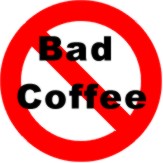
|
Quote of the day..." Drink Good Coffee. You can sleep when you're DEAD! "
author unknown, but passed on to me by Robert Holland on the Homeroast List--Thanks! |
 Back to the Main Menu
Back to the Main Menu
